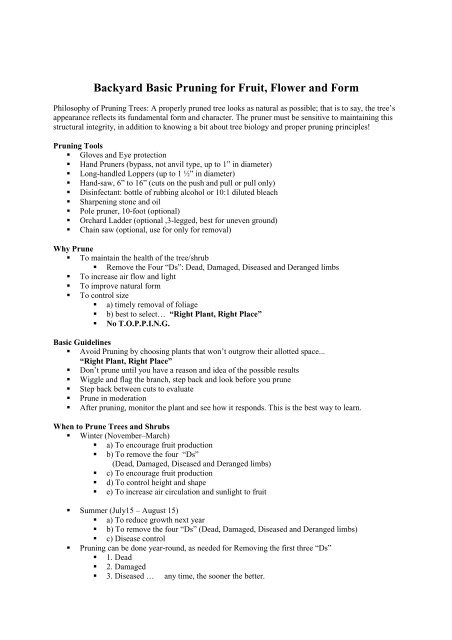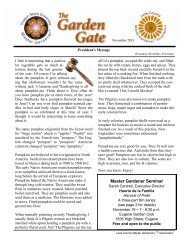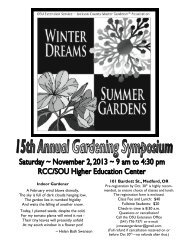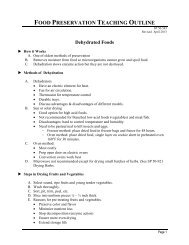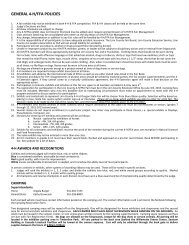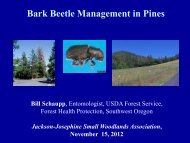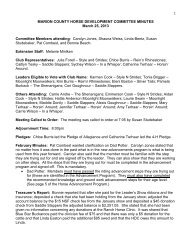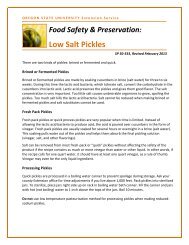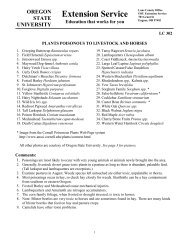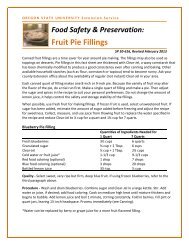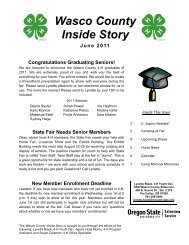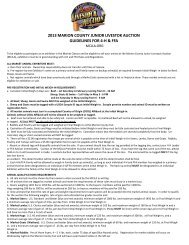Backyard Basic Pruning for Fruit, Flower and Form - Oregon State ...
Backyard Basic Pruning for Fruit, Flower and Form - Oregon State ...
Backyard Basic Pruning for Fruit, Flower and Form - Oregon State ...
Create successful ePaper yourself
Turn your PDF publications into a flip-book with our unique Google optimized e-Paper software.
<strong>Backyard</strong> <strong>Basic</strong> <strong>Pruning</strong> <strong>for</strong> <strong>Fruit</strong>, <strong>Flower</strong> <strong>and</strong> <strong>Form</strong><br />
Philosophy of <strong>Pruning</strong> Trees: A properly pruned tree looks as natural as possible; that is to say, the tree’s<br />
appearance reflects its fundamental <strong>for</strong>m <strong>and</strong> character. The pruner must be sensitive to maintaining this<br />
structural integrity, in addition to knowing a bit about tree biology <strong>and</strong> proper pruning principles!<br />
<strong>Pruning</strong> Tools<br />
Gloves <strong>and</strong> Eye protection<br />
H<strong>and</strong> Pruners (bypass, not anvil type, up to 1” in diameter)<br />
Long-h<strong>and</strong>led Loppers (up to 1 ½” in diameter)<br />
H<strong>and</strong>-saw, 6” to 16” (cuts on the push <strong>and</strong> pull or pull only)<br />
Disinfectant: bottle of rubbing alcohol or 10:1 diluted bleach<br />
Sharpening stone <strong>and</strong> oil<br />
Pole pruner, 10-foot (optional)<br />
Orchard Ladder (optional ,3-legged, best <strong>for</strong> uneven ground)<br />
Chain saw (optional, use <strong>for</strong> only <strong>for</strong> removal)<br />
Why Prune<br />
To maintain the health of the tree/shrub<br />
Remove the Four “Ds”: Dead, Damaged, Diseased <strong>and</strong> Deranged limbs<br />
To increase air flow <strong>and</strong> light<br />
To improve natural <strong>for</strong>m<br />
To control size<br />
a) timely removal of foliage<br />
b) best to select… “Right Plant, Right Place”<br />
No T.O.P.P.I.N.G.<br />
<strong>Basic</strong> Guidelines<br />
Avoid <strong>Pruning</strong> by choosing plants that won’t outgrow their allotted space...<br />
“Right Plant, Right Place”<br />
Don’t prune until you have a reason <strong>and</strong> idea of the possible results<br />
Wiggle <strong>and</strong> flag the branch, step back <strong>and</strong> look be<strong>for</strong>e you prune<br />
Step back between cuts to evaluate<br />
Prune in moderation<br />
After pruning, monitor the plant <strong>and</strong> see how it responds. This is the best way to learn.<br />
When to Prune Trees <strong>and</strong> Shrubs<br />
Winter (November–March)<br />
a) To encourage fruit production<br />
b) To remove the four “Ds”<br />
(Dead, Damaged, Diseased <strong>and</strong> Deranged limbs)<br />
c) To encourage fruit production<br />
d) To control height <strong>and</strong> shape<br />
e) To increase air circulation <strong>and</strong> sunlight to fruit<br />
Summer (July15 – August 15)<br />
a) To reduce growth next year<br />
b) To remove the four “Ds” (Dead, Damaged, Diseased <strong>and</strong> Deranged limbs)<br />
c) Disease control<br />
<strong>Pruning</strong> can be done year-round, as needed <strong>for</strong> Removing the first three “Ds”<br />
1. Dead<br />
2. Damaged<br />
3. Diseased … any time, the sooner the better.
When you Prune it will have an Effect<br />
<strong>Pruning</strong> done during the dormant season tends to have an invigorating effect on tree growth.<br />
<strong>Pruning</strong> done during peak growth times tends to slow growth by removing leaves that<br />
manufacture nourishment.<br />
<strong>Pruning</strong> during the spring (post-dormancy) <strong>and</strong> fall (pre-dormancy) is generally the least<br />
desirable time as the plant is most vulnerable during those times.<br />
<strong>Basic</strong> Guidelines<br />
Berries <strong>and</strong> Tree fruits are pruned November until bloom<br />
Spring Blooming ornamentals during <strong>and</strong> immediately after bloom<br />
Summer blooming shrubs start setting flower buds in spring, most are pruned in early spring<br />
Conifers ooze or bleed sap during active growth, prune from fall to mid winter<br />
Anatomy of a Tree Parts of the Branch<br />
Trunk Terminal bud<br />
Leader Leaf bud<br />
Scaffold branch Bud scar<br />
Lateral branch <strong>Flower</strong> bud<br />
Roots <strong>Fruit</strong> or <strong>Flower</strong> spurs<br />
Suckers or Water Sprouts
Types of <strong>Pruning</strong> Cuts<br />
Thinning Cuts: Branches are removed entirely, leaving no buds to grow. Their energy is<br />
diverted into remaining branches, which grow more vigorously.<br />
Heading Cuts: Several buds left on the cut branch grow, making denser, more compact<br />
foliage on more branches.
Why Prune <strong>Fruit</strong> trees<br />
increase fruit production<br />
develop strong 45-degree scaffold branches<br />
remove limbs that grow down or straight up<br />
maintain tree size ~10-12’<br />
maintain fruit spurs<br />
Where Does the <strong>Fruit</strong> Grow?<br />
Plum/prune - 1st year wood -- that grew last year.<br />
Peach/nectarine - 1st year wood -- that grew last year.<br />
Cherry - 1st <strong>and</strong> 2nd year wood - (Look <strong>for</strong> fruit spurs.)<br />
Apple/Pear - 2nd year wood.<br />
Filbert/hazelnuts - Mainly 1st year wood.<br />
Walnuts 1st <strong>and</strong> 2nd year wood.<br />
Types of Tree <strong>Form</strong>s<br />
Central Leader<br />
Modified Central Leader<br />
Vase or Multiple Leader<br />
Types of Shrub <strong>Form</strong>s<br />
Cane - Plants that renew themselves by sending up new branches – called canes – from the<br />
base. <strong>Pruning</strong> out canes at the base of the plant to increase air <strong>and</strong> sun.<br />
Mounding - The plants look like mounds <strong>and</strong> are medium-tough plants. Found in mass<br />
planting. They have small leaves <strong>and</strong> supple branches. <strong>Pruning</strong> can be done as thinning cuts<br />
to tidy them up or reduce their size. This type of shrub can be sheared, shearing is heading<br />
cuts <strong>and</strong> that stimulates growth.<br />
Tree <strong>for</strong>m – It is best to let it get big. Not to be pruned heavy-h<strong>and</strong>edly. Good selective<br />
pruning can open up the shrub <strong>and</strong> make it look less oppressive; you can train branches<br />
around gutters <strong>and</strong> off the house <strong>and</strong> to enhance the natural beauty of the shrub.<br />
List of supporting books:<br />
• American Horticultural Society <strong>Pruning</strong> & Training<br />
by Christopher Brickell (Author), David Joyce (Author)<br />
• Cass Turnbull's Guide to <strong>Pruning</strong>: What, When, <strong>and</strong> Where <strong>and</strong> How to Prune <strong>for</strong> a More<br />
Beautiful Garden, by Cass Turnbull (Author), Kate Allen (Illustrator)<br />
• <strong>Pruning</strong> Made Easy: A Gardener's Visual Guide to When <strong>and</strong> How to Prune Everything, from<br />
<strong>Flower</strong>s to Trees, Storey's Gardening Skills Illustrated, by Lewis Hill (Author)<br />
• The Gossler Guide to the Best Hardy Shrubs: More than 350 Expert Choices <strong>for</strong> Your Garden<br />
by Roger Gossler, Eric Gossler, <strong>and</strong> Marjory Gossler (Authors)<br />
Recommended Publications:<br />
PNW 400 Training <strong>and</strong> <strong>Pruning</strong> Your Home Orchard<br />
http://ir.library.oregonstate.edu/xmlui/bitstream/h<strong>and</strong>le/1957/22166/pnw400.pdf<br />
WSU EB 1619 <strong>Pruning</strong> L<strong>and</strong>scape Trees<br />
http://cru.cahe.wsu.edu/CEPublications/eb1619/eb1619.pdf<br />
Recommended Websites <strong>for</strong> Trees:<br />
http://oregonstate.edu/trees/index.html<br />
http://www.arborday.org/trees/rightTreeAndPlace/index.cfm<br />
http://orb.at.ufl.edu/TREES/index.html


